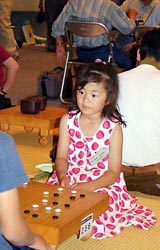 |
|
| Clam-shell go stones | |
 |
|
| Clam-shell go stones | |
 |
|
| Tournament in Hyuga-city, Miyazaki | |
| Every year, during the rainy season. I come home to Japan for the World Amateur Go Championship. This year the tournament was held in the city of Hyuga, well know to go fans for its clam-shell go stones. | |
 |
|
| It goes without saying that the WAGC was a magnificent
tournament -- what surprised me was that clam-shell stones were used in
all the games. Not only in the main event, the WAGC, but also in the children's
tournament and in games played by the general public -- everything was
done in style. Usually in Europe the stones are plastic, or, if you're lucky, glass. I was so envious, my head spun. |
|
| This is my fifth year in Europe. I'm worried about my tetsuki (the way one holds the go stones) -- it's gradually become slovenly. My skin also seems to have become slack . . . Eh? that's age? Well, putting that aside, my posture sitting at the go board and the lack of beauty of my play are a shock to me because of their lack of professionalism. | |
|
Not using proper stones, not playing serious, competitive
games, playing too few games -- these are the reasons that occur to me
and they all seem valid. Using proper equipment: this is especially important for children, I think. For example, suppose you drop a stone. Children quickly pick it up. After a brief glance around, they wipe it clean on their clothes and put it back in the bowl. No one has taught them to do this; they probably realize instinctively that clam-shell go stones are special. And this feeling communicates itself to the adults and foreigners watching them. This kind of trivial thing nurtures good manners and respect for things. |
|
 |
|
|
And yet, not only in Europe but in other countries
outside Asia, it's extremely difficult to get a complete set of go equipment.
Japanese-made equipment is super expensive; moreover, it's in scarce supply. Because of this, one often encounters very interesting -- sometimes unique -- go equipment in different countries. A board is relatively easy to make -- you can do it just by drawing a grid on cardboard or a piece of wood -- but stones are difficult. Buttons, caps of juice bottles that have been coloured in, chips of wood, 'bread stones' of solid flour, etc., etc. I am often filled with admiration for people's inventiveness, unimaginable to someone like me brought up in Japan, which is overflowing with material things. |
|
 |
|
| A few years ago, someone in the Czech Republic started manufacturing go equipment, so things have changed. The Czech Republic has low prices and plenty of wood, and large-scale production keeps the prices low; the country is conveniently located for supplying other countries and this helps popularize go. It's killing two birds with one stone. | |
| The boards, made from pieces of wood joined together, may not be kaya, but they are pretty. The main product is a 2-cm table board that sells for about 4,000 yen. The stones, which are of plastic or glass, are a tougher proposition. Stones will probably be a problem long into the future. | |
|
By the way, in my own home we use a Czech go set --
it looks just as good as the real thing. On the final day of the WAGC tournament, the participants were given sets of go stones by Hyuga City. This is a great idea. Everyone was really happy and grateful, while I was envious. |
|
 |
|
|
One of the players said that when he went home he
was going to look for shells and try manufacturing go stones himself. That
won't be easy, but, even if they have no money, go fans overseas are happy
to give up their time for the game.Who know? It might lead to something.
This thought occurs to me as I eat the spaghetti vongole that's one of
my husband's best dishes. (August 2001, Monthly Go World) |
|